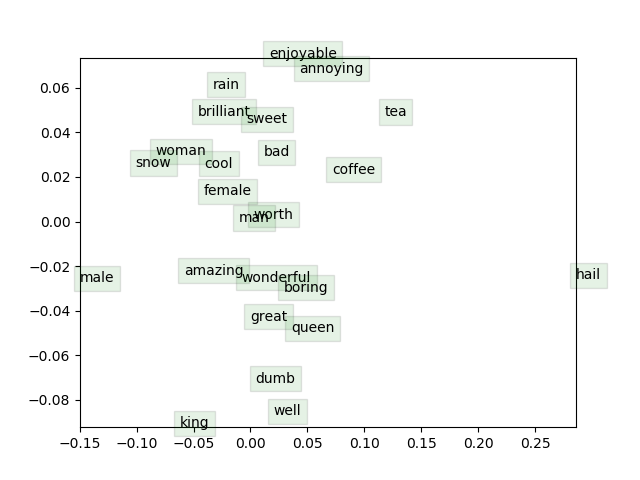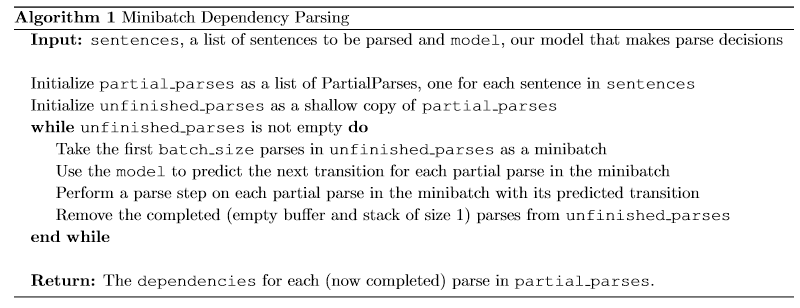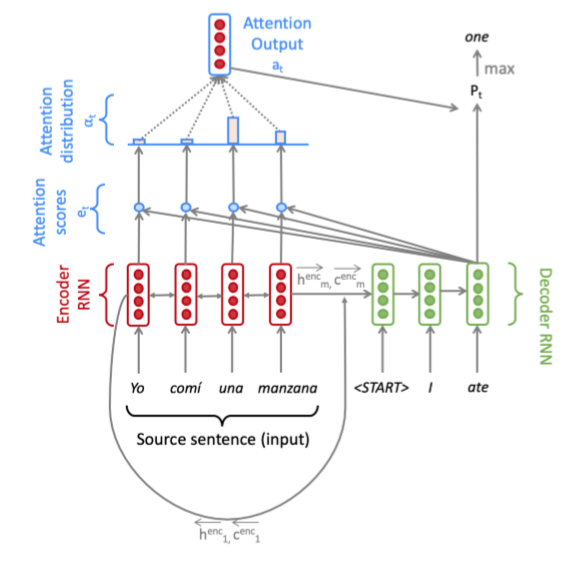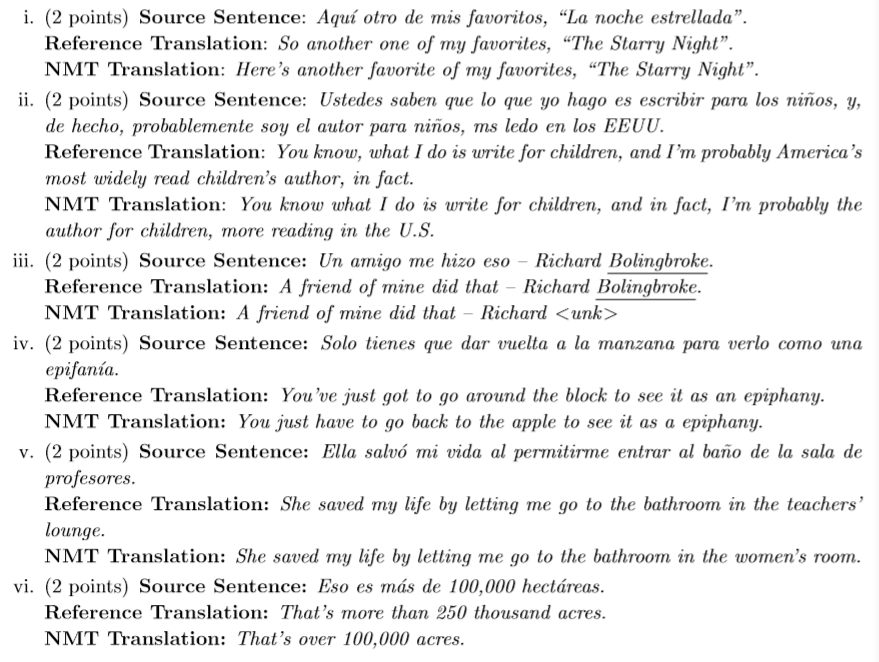CS224n-2019 Assignment¶
本文档将记录作业中的要点以及问题的答案
课程笔记参见我的博客,并在博客的Repo中提供笔记源文件的下载
Assignment 01¶
- 逐步完成共现矩阵的搭建,并调用
sklearn.decomposition中的TruncatedSVD完成传统的基于SVD的降维算法 - 可视化展示,观察并分析其在二维空间下的聚集情况。
- 载入Word2Vec,将其与SVD得到的单词分布情况进行对比,分析两者词向量的不同之处。
- 学习使用
gensim,使用Cosine Similarity分析单词的相似度,对比单词和其同义词与反义词的Cosine Distance,并尝试找到正确的与错误的类比样例 - 探寻Word2Vec向量中存在的
Independent Bias问题
Assignment 02¶
1 Written: Understanding word2vec¶
真实(离散)概率分布 \(p\) 与另一个分布 \(q\) 的交叉熵损失为 \(-\sum_i p_{i} \log \left(q_{i}\right)\)
Question a
Show that the naive-softmax loss given in Equation (2) is the same as the cross-entropy loss between \(y\) and \(\hat y\); i.e., show that
Your answer should be one line.
Answer a :
因为 \(\textbf{y}\) 是独热向量,所以 \(-\sum_{w \in Vocab} y_{w} \log (\hat{y}_{w})=-y_o\log (\hat{y}_{o}) -\sum_{w \in Vocab,w \neq o} y_{w} \log (\hat{y}_{w}) = -\log (\hat{y}_{o})\)
Question b
Compute the partial derivative of \(J_{\text{naive-softmax}}(v_c, o, \textbf{U})\) with respect to \(v_c\). Please write your answer in terms of \(\textbf{y}, \hat {\textbf{y}}, \textbf{U}\).
Answer b :
Question c
Compute the partial derivatives of \(J_{\text{naive-softmax}}(v_c, o, \textbf{U})\) with respect to each of the ‘outside' word vectors, \(u_w\)'s. There will be two cases: when \(w = o\), the true ‘outside' word vector, and \(w \neq o\), for all other words. Please write you answer in terms of \(\textbf{y}, \hat {\textbf{y}}, \textbf{U}\).
Answer c : $$ \begin{array}{l} {\frac{\partial J\left(v_{c}, o, U\right)}{\partial u_{w}}}
&={-\frac{\partial\left(u_{o}^{T} v_{c}\right)}{\partial u_{w}}+\frac{\partial \left(\log \left(\sum_{w} \exp \left(u_{w}^{T} v_{c}\right)\right)\right)}{\partial u_{w}}} \end{array} $$
When \(w \neq o\) :
When \(w = o\) :
Then :
Question d
The sigmoid function is given by the follow Equation :
Please compute the derivative of \(\sigma (x)\) with respect to \(x\), where \(x\) is a vector.
Answer d :
Question e
Now we shall consider the Negative Sampling loss, which is an alternative to the Naive Softmax loss. Assume that \(K\) negative samples (words) are drawn from the vocabulary. For simplicity of notation we shall refer to them as \(w_{1}, w_{2}, \dots, w_{K}\) and their outside vectors as \(u_{1}, \dots, u_{K}\). Note that \(o \notin\left\{w_{1}, \dots, w_{K}\right\}\). For a center word \(c\) and an outside word \(o\), the negative sampling loss function is given by:
for a sample \(w_{1}, w_{2}, \dots, w_{K}\), where \(\sigma(\cdot)\) is the sigmoid function.
Please repeat parts b and c, computing the partial derivatives of \(J_{\text { neg-sample }}\) respect to \(v_c\), with respect to \(u_o\), and with respect to a negative sample \(u_k\). Please write your answers in terms of the vectors \(u_o, v_c,\) and \(u_k\), where \(k \in[1, K]\). After you've done this, describe with one sentence why this loss function is much more efficient to compute than the naive-softmax loss. Note, you should be able to use your solution to part (d) to help compute the necessary gradients here.
Answer e :
For \(v_c\) :
For \(u_o\), Remeber : \(o \notin\left\{w_{1}, \dots, w_{K}\right\}\) 
For \(u_k\) :
Why this loss function is much more efficient to compute than the naive-softmax loss?
For naive softmax loss function:
For negative sampling loss function:
从求得的偏导数中我们可以看出,原始的softmax函数每次对 \(v_c\) 进行反向传播时,需要与 output vector matrix 进行大量且复杂的矩阵运算,而负采样中的计算复杂度则不再与词表大小 \(V\) 有关,而是与采样数量 \(K\) 有关。
Question f
Suppose the center word is \(c = w_t\) and the context window is \(\left[w_{t-m}, \ldots, w_{t-1}, w_{t}, w_{t+1}, \dots,w_{t+m} \right]\), where \(m\) is the context window size. Recall that for the skip-gram version of word2vec, the total loss for the context window is
Here, \(J\left(v_{c}, w_{t+j}, \boldsymbol{U}\right)\) represents an arbitrary loss term for the center word \(c = w_t\) and outside word \(w_t+j\) . \(J\left(v_{c}, w_{t+j}, \boldsymbol{U}\right)\) could be \(J_{\text {naive-softmax}}\left(v_{c}, w_{t+j}, \boldsymbol{U}\right)\) or \(J_{\text {neg-sample}}\left(v_{c}, w_{t+j}, \boldsymbol{U}\right)\), depending on your implementation.
Write down three partial derivatives:
Write your answers in terms of \(\partial \boldsymbol{J}\left(\boldsymbol{v}_{c}, w_{t+j}, \boldsymbol{U}\right) / \partial \boldsymbol{U}\) and \(\partial \boldsymbol{J}\left(\boldsymbol{v}_{c}, w_{t+j}, \boldsymbol{U}\right) / \partial \boldsymbol{v_c}\). This is very simple - each solution should be one line.
Once you're done: Given that you computed the derivatives of \(\partial \boldsymbol{J}\left(\boldsymbol{v}_{c}, w_{t+j}, \boldsymbol{U}\right)\) with respect to all the model parameters \(U\) and \(V\) in parts a to c, you have now computed the derivatives of the full loss function \(J_{skip-gram}\) with respect to all parameters. You're ready to implement word2vec !
Answer f : $$ \begin{array}{l} \frac{\partial J_{s g}}{\partial U} &= \sum_{-m \leq j \leq m, j \neq 0} \frac{\partial J\left(v_{c}, w_{t+j}, U\right)}{\partial U} \ \frac{\partial J_{s g}}{\partial v_{c}}&= \sum_{-m \leq j \leq m, j \neq 0} \frac{\partial J\left(v_{c}, w_{t+j}, U\right)}{\partial v_{c}} \ \frac{\partial J_{s g}}{\partial v_{w}}&=0(\text { when } w \neq c) \end{array} $$
2 Coding: Implementing word2vec¶
word2vec.py¶
本部分要求实现 \(sigmoid, naiveSoftmaxLossAndGradient, negSamplingLossAndGradient, skipgram\) 四个函数,主要考察对第一部分中反向传播计算结果的实现。代码实现中,通过优化偏导数结合偏导数计算结果与 \(\sigma(x) + \sigma(-x) = 1\) 对公式进行转化,从而实现了全矢量化。这部分需要大家自行结合代码与公式进行推导。
sgd.py¶
实现 SGD $$ \theta^{n e w}=\theta^{o l d} - \alpha \nabla_{\theta} J(\theta) $$
run.py¶
首先要说明的是,这个真的要跑好久
Question
Briefly explain in at most three sentences what you see in the plot.
上图是经过训练的词向量的可视化。我们可以注意到一些模式:
- 近义词被组合在一起,比如 amazing 和 wonderful,woman 和 female。
- 但是 man 和 male 却距离较远
- 反义词可能因为经常属于同一上下文,它们也会与同义词一起出现,比如 enjoyable 和 annoying。
man:king::woman:queen以及queen:king::female:male形成的两条直线基本平行
Assignment 03¶
1. Machine Learning & Neural Networks¶
(a) Adam Optimizer¶
回忆一下标准随机梯度下降的更新规则 $$ \boldsymbol{\theta} \leftarrow \boldsymbol{\theta}-\alpha \nabla_{\boldsymbol{\theta}}{J_{\mathrm{minibatch}}(\boldsymbol{\theta})} $$ 其中,\(\boldsymbol{\theta}\) 是包含模型所有参数的向量,\(J\) 是损失函数,\(\nabla_{\boldsymbol{\theta}} J_{\mathrm{minibatch}}(\boldsymbol{\theta})\) 是关于minibatch数据上参数的损失函数的梯度,\(\alpha\) 是学习率。Adam Optimization使用了一个更复杂的更新规则,并附加了两个步骤。
Question 1.a.i
首先,Adam使用了一个叫做 \(momentum\) 动量的技巧来跟踪梯度的移动平均值 \(m\)
其中,\(\beta_1\) 是一个 0 和 1 之间的超参数(通常被设为0.9)。简要说明(不需要用数学方法证明,只需要直观地说明)如何使用m来阻止更新发生大的变化,以及总体上为什么这种小变化可能有助于学习。
Answer 1.a.i :
-
由于超参数 \(\beta _1\) 一般被设为0.9,此时对于移动平均的梯度值 \(m\) 而言,主要受到的是之前梯度的移动平均值的影响,而本次计算得到的梯度将会被缩放为原来的 \({1 - \beta_1}\) 倍,即时本次计算得到的梯度很大(梯度爆炸),这一影响也会被减轻,从而阻止更新发生大的变化。
-
通过减小梯度的变化程度,使得每次的梯度更新更加稳定,从而使模型学习更加稳定,收敛速度更快,并且这也减慢了对于较大梯度值的参数的更新速度,保证其更新的稳定性。
Question 1.a.ii
Adam还通过跟踪梯度平方的移动平均值 \(v\) 来使用自适应学习率
其中,\(\odot, /\) 分别表示逐元素的乘法和除法(所以 \(z \odot z\) 是逐元素的平方),\(\beta_2\) 是一个 0 和 1 之间的超参数(通常被设为0.99)。因为Adam将更新除以 \(\sqrt v\) ,那么哪个模型参数会得到更大的更新?为什么这对学习有帮助?
Answer 1.a.ii :
- 移动平均梯度最小的模型参数将得到较大的更新。
- 一方面,将梯度较小的参数的更新变大,帮助其走出局部最优点(鞍点);另一方面,将梯度较大的参数的更新变小,使其更新更加稳定。结合以上两个方面,使学习更加快速的同时也更加稳定。
(b) Dropout¶
Dropout 是一种正则化技术。在训练期间,Dropout 以 \(p_{drop}\) 的概率随机设置隐藏层 \(h\) 中的神经元为零(每个minibatch中 dropout 不同的神经元),然后将 \(h\) 乘以一个常数 \(\gamma\) 。我们可以写为
其中,\(d \in \{0,1\}^{D_h}\) ( \(D_h\) 是 \(h\) 的大小)是一个掩码向量,其中每个条目都是以 \(p_{drop}\) 的概率为 0 ,以 \(1 - p_{drop}\) 的概率为 1。\(\gamma\) 是使得 \(h_{drop}\) 的期望值为 \(h\) 的值
Question 1.b.i
\(\gamma\) 必须等于什么(用 \(p_{drop}\) 表示) ?简单证明你的答案。
Answer 1.b.i :
证明如下:
Question 1.b.ii
为什么我们应该只在训练时使用 dropout 而在评估时不使用?
Answer 1.b.ii :
如果我们在评估期间应用 dropout ,那么评估结果将会具有随机性,并不能体现模型的真实性能,违背了正则化的初衷。通过在评估期间禁用 dropout,从而观察模型的性能与正则化的效果,保证模型的参数得到正确的更新。
2. Neural Transition-Based Dependency Parsing¶
在本节中,您将实现一个基于神经网络的依赖解析器,其目标是在UAS(未标记依存评分)指标上最大化性能。
依存解析器分析句子的语法结构,在 head words 和 修饰 head words 的单词之间建立关系。你的实现将是一个基于转换的解析器,它逐步构建一个解析。每一步都维护一个局部解析,表示如下
- 一个存储正在被处理的单词的 栈
- 一个存储尚未处理的单词的 缓存
- 一个解析器预测的 依赖 的列表
最初,栈只包含 ROOT ,依赖项列表是空的,而缓存则包含了这个句子的所有单词。在每一个步骤中,解析器将对部分解析使用一个转换,直到它的魂村是空的,并且栈大小为1。可以使用以下转换:
- SHIFT:将buffer中的第一个词移出并放到stack上。
- LEFT-ARC:将第二个(最近添加的第二)项标记为栈顶元素的依赖,并从堆栈中删除第二项
- RIGHT-ARC:将第一个(最近添加的第一)项标记为栈中第二项的依赖,并从堆栈中删除第一项
在每个步骤中,解析器将使用一个神经网络分类器在三个转换中决定。
Question 2.a
求解解析句子 “I parsed this sentence correctly” 所需的转换顺序。这句话的依赖树如下所示。在每一步中,给出 stack 和 buffer 的结构,以及本步骤应用了什么转换,并添加新的依赖(如果有的话)。下面提供了以下三个步骤。
Answer 2.a :
| Stack | Buffer | New dependency | Transition |
|---|---|---|---|
| [ROOT] | [I, parsed, this, sentence, correctly] | Initial Configuration | |
| [ROOT, I] | [parsed, this, sentence, correctly] | SHIFT | |
| [ROOT, I, parsed] | [this, sentence, correctly] | SHIFT | |
| [ROOT, parsed] | [this, sentence, correctly] | parsed \(\to\) I | LEFT-ARC |
| [ROOT, parsed, this] | [sentence, correctly] | SHIFT | |
| [ROOT, parsed, this, sentence] | [correctly] | SHIFT | |
| [ROOT, parsed, sentence] | [correctly] | sentence \(\to\) this | LEFT-ARC |
| [ROOT, parsed] | [correctly] | parsed \(\to\) sentence | RIGHT-ARC |
| [ROOT, parsed, correctly] | [] | SHIFT | |
| [ROOT, parsed] | [] | parsed \(\to\) correctly | RIGHT-ARC |
| [ROOT] | [] | ROOT \(\to\) parsed | RIGHT-ARC |
Question 2.b
一个包含 \(n\) 个单词的句子需要多少步(用 \(n\) 表示)才能被解析?简要解释为什么。
Answer 2.b :
包含\(n\)个单词的句子需要 \(2 \times n\) 步才能完成解析。因为需要进行 \(n\) 步的 \(SHIFT\) 操作和 共计$n 步的 LEFT-ARC 或 RIGHT-ARC 操作,才能完成解析。(每个单词都需要一次SHIFT和ARC的操作,初始化步骤不计算在内)
Question 2.c
实现解析器将使用的转换机制
Question 2.d
我们的网络将预测哪些转换应该应用于部分解析。我们可以使用它来解析一个句子,通过应用预测出的转换操作,直到解析完成。然而,在对大量数据进行预测时,神经网络的运行速度要高得多(即同时预测了对任何不同部分解析的下一个转换)。我们可以用下面的算法来解析小批次的句子
实现minibatch的解析器
我们现在将训练一个神经网络来预测,考虑到栈、缓存和依赖项集合的状态,下一步应该应用哪个转换。首先,模型提取了一个表示当前状态的特征向量。我们将使用原神经依赖解析论文中的特征集合:A Fast and Accurate Dependency Parser using Neural Networks。这个特征向量由标记列表(例如在栈中的最后一个词,缓存中的第一个词,栈中第二到最后一个字的依赖(如果有))组成。它们可以被表示为整数的列表\([w_1,w_2,\dots,w_m]\),m是特征的数量,每个 \(0 \leq w_i \lt |V|\) 是词汇表中的一个token的索引(\(| V |\)是词汇量)。首先,我们的网络查找每个单词的嵌入,并将它们连接成一个输入向量:
其中 \(\mathbf{E} \in \mathbb{R}^{|V| \times d}\) 是嵌入矩阵,每一行 \(\mathbf{E}_w\) 是一个特定的单词 \(w\) 的向量。接着我们可以计算我们的预测:
其中, \(\mathbf{h}\) 指的是隐藏层,\(\mathbf{l}\) 是其分数,\(\mathbf{\hat y}\) 指的是预测结果, \(\text{ReLU(z)}=max(z,0)\) 。我们使用最小化交叉熵损失来训练模型
训练集的损失为所有训练样本的 \(J(\theta)\) 的平均值。
Question 2.f
我们想看看依赖关系解析的例子,并了解像我们这样的解析器在什么地方可能是错误的。例如,在这个句子中:
依赖 \(\text{into Afghanistan}\) 是错的,因为这个短语应该修饰 \(\text{sent}\) (例如 \(\text{sent into Afghanistan}\)) 而不是 \(\text{troops}\) (因为 \(\text{ troops into Afghanistan}\) 没有意义)。下面是正确的解析:
一般来说,以下是四种解析错误:
- Prepositional Phrase Attachment Error 介词短语连接错误:在上面的例子中,词组 \(\text{into Afghanistan}\) 是一个介词短语。介词短语连接错误是指介词短语连接到错误的 head word 上(在本例中,troops 是错误的 head word ,sent 是正确的 head word )。介词短语的更多例子包括with a rock, before midnight和under the carpet。
- Verb Phrase Attachment Error 动词短语连接错误:在句子\(\text{leave the store alone, I went out to watch the parade}\)中,短语 \(\text{leave the store alone}\) 是动词短语。动词短语连接错误是指一个动词短语连接到错误的 head word 上(在本例中,正确的头词是 \(\text{went}\))。
- Modifier Attachment Error 修饰语连接错误:在句子 \(\text{I am extremely short}\) 中,副词extremely 是形容词 short 的修饰语。修饰语附加错误是修饰语附加到错误的 head word 上时发生的错误(在本例中,正确的头词是 short)。
- Coordination Attachment Error 协调连接错误:在句子 \(\text{Would you like brown rice or garlic naan?}\) 中, brown rice 和garlic naan都是连词,or是并列连词。第二个连接词(这里是garlic naan)应该连接到第一个连接词(这里是brown rice)。协调连接错误是当第二个连接词附加到错误的 head word 上时(在本例中,正确的头词是rice)。其他并列连词包括and, but和so。
在这个问题中有四个句子,其中包含从解析器获得的依赖项解析。每个句子都有一个错误,上面四种类型都有一个例子。对于每个句子,请说明错误的类型、不正确的依赖项和正确的依赖项。为了演示:对于上面的例子,您可以这样写:
- Error type: Prepositional Phrase Attachment Error
- Incorrect dependency: troops \(\to\) Afghanistan
- Correct dependency: sent \(\to\) Afghanistan
注意:依赖项注释有很多细节和约定。如果你想了解更多关于他们的信息,你可以浏览UD网站:http://universaldependencies.org。然而,你不需要知道所有这些细节就能回答这个问题。在每一种情况下,我们都在询问短语的连接,应该足以看出它们是否修饰了正确的head。特别是,你不需要查看依赖项边缘上的标签——只需查看边缘本身就足够了。
Answer 2.f
- Error type: Verb Phrase Attachment Error
- Incorrect dependency: wedding \(\to\) fearing
- Correct dependency: heading \(\to\) fearing
- Error type: Coordination Attachment Error
- Incorrect dependency: makes \(\to\) rescue
- Correct dependency: rush \(\to\) rescue
- Error type: Prepositional Phrase Attachment Error
- Incorrect dependency: named \(\to\) Midland
- Correct dependency: guy \(\to\) Midland
- Error type: Modifier Attachment Error
- Incorrect dependency: elements \(\to\) most
- Correct dependency: crucial \(\to\) most
Assignment 04¶
1. Neural Machine Translation with RNNs¶
在机器翻译中,我们的目标是将一个句子从源语言(如西班牙语)转换成目标语言(如英语)。在本作业中,我们将注意实现一个序列到序列(Seq2Seq)网络,以建立一个神经机器翻译(NMT)系统。在本节中,我们描述了使用双向LSTM编码器和单向LSTM解码器的NMT系统的训练过程。
上图是使用乘法注意力的Seq2Seq模型,显示了解码器的第三步。注意,为了可读性,我们不描绘前一个组合输出与解码器输入的连接。
给定源语言中的一个句子,我们从词嵌入矩阵中查找单词嵌入,得到 \(\mathbf{x}_{1}, \dots, \mathbf{x}_{m} | \mathbf{x}_{i} \in \mathbb{R}^{e \times 1}\) ,其中 \(m\) 为源语句的长度,\(e\) 为嵌入大小。我们将这些嵌入提供给双向编码器,为正向(\(\rightarrow\))和反向(\(\leftarrow\))LSTMs生成隐藏状态和单元格状态。前向和后向的版本连接起来,以得到隐藏状态 \(\mathbf{h}_{i}^{\mathrm{enc}}\) 和单元格状态 \(\mathbf{c}_{i}^{\mathrm{enc}}\)
然后,我们使用编码器的最终隐藏状态和最终单元状态的线性投影,初始化解码器的第一个隐藏状态 \(\mathbf{h}_{0}^{\mathrm{dec}}\) 和单元状态 \(\mathbf{c}_{0}^{\mathrm{dec}}\)
初始化解码器之后,现在必须用目标语言为它提供匹配的句子。在第 \(t\) 步,我们查找第 \(t\) 个单词的嵌入,\(\mathbf{y}_{t} \in \mathbb{R}^{e \times 1}\) 。然后,我们将 \(y_t\) 与前一个时间步的 combined-output 组合输出向量 \(\mathbf{o}_{t-1} \in \mathbb{R}^{h \times 1}\) 连接起来(我们将在下一页解释这是什么!),得到 \(\overline{\mathbf{y}_{t}} \in \mathbb{R}^{(e+h) \times 1}\) 。注意,对于第一个目标单词(即 start 标记),\(o_0\)是一个零向量。然后将 \(\overline{\mathbf{y}_{t}}\) 作为输入输入到解码器LSTM中。
然后我们用 \(\mathbf{h}_{t}^{\mathrm{dec}}\) 来计算在 \(\mathbf{h}_{0}^{\mathrm{enc}}, \ldots, \mathbf{h}_{m}^{\mathrm{enc}}\) 上的乘法注意
现在,我们将注意力输出 \(\alpha_t\) 与解码器隐藏状态 \(\mathbf{h}_{t}^{\mathrm{dec}}\) 连接起来,并将其通过线性层 Tanh 和 Dropout 来获得组合输出向量 \(o_t\) 。
然后,在第 \(t\) 个时间步长时,得到目标词的概率分布 \(\mathbf{P}_{t}\)
这里, \(V_t\) 是目标词汇表的大小。最后,为了训练网络,我们计算了 \(\mathbf{P}_{t} ,\mathbf{g}_{t}\) 之间的 softmax 交叉熵损失,\(\mathbf{g}_{t}\) 是时间步 \(t\) 的目标词的 one-hot 向量
在这里,\(\theta\) 代表所有的模型参数,\(J_t(\theta)\)是解码器第 \(t\) 步的损失。现在我们已经描述了该模型,让我们尝试将其实现为西班牙语到英语的翻译!
Pytorch Bidirectional RNNs Note
Pytorch 中的 RNNs,返回的 out 的 shape 为 \(\text{(seq_len, batch, num_directions * hidden_size)}\)
- 转换为 \(\text{(seq_len, batch, num_directions, hidden_size)}\) 后,num_directions 中的顺序是先 forward 再 backward,并且 forward 和 backward 的 hidden state 的顺序是相反的,即 \(out[0][0][0]\) 是 forward 的第一个时间步的结果,而 \(out[0][0][1]\) 是 backward 的最后一个时间步的结果。此外,out 只包含最后一层的结果
但对于 h_n ( c_n 同理) 而言,shape 为 \(\text{(num_layers * num_directions, batch, hidden_size)}\) ,保存的是 forward 和 backward 的最后一个时间步的结果。
- 转换为 \(\text{(num_layers, num_directions, batch, hidden_size)}\) 后,第一维的 num_layers 和 真实的 layer 层数一一对应,即 \(h_n[1][0][0]\) 与 \(out[-1][0][0]\) 相等, \(h_n[1][1][0]\) 与 \(out[0][0][1]\) 。
Question 1.g
首先解释(大约三句话) masks 对整个注意力计算有什么影响。然后(用一两句话)解释为什么有必要这样使用 masks 。
Answer 1.g
- 使用 masks 将句子中的 pad token 的分数赋值为 \(-inf\) ,从而使得 softmax 作用后获得的 attention 分布中,pad token 的 attention 概率值近似为 0
- attention score / distributions 计算的是 decoder 中某一时间步上的 target word 对 encoder 中的所有 source word 的注意力概率,而 pad token 只是用于 mini-batch ,并没有任何语言意义,target word 无须为其分散注意力,所以需要使用 masks 过滤掉 pad token
Question 1.j
在课堂上,我们学习了点积注意、乘法注意和加法注意。请就其他两种注意机制中的任何一种,提供每种注意机制可能的优点和缺点
- 点积注意 \(\mathbf{e}_{t, i}=\mathbf{s}_{t}^{T} \mathbf{h}_{i}\)
- 乘法注意 \(\mathbf{e}_{t, i}=\mathbf{s}_{t}^{T} \mathbf{W h}_{i}\)
- 加法注意 \(\mathbf{e}_{t, i}=\mathbf{v}^{T}(\mathbf{W}_{1} \mathbf{h}_{i}+\mathbf{W}_{2} \mathrm{s}_{t} )\)
Answer 1.j
| 优点 | 缺点 | |
|---|---|---|
| 点积注意力 | 不需要额外的线性映射层 | \(s_t, h_t\) 必须有同样的纬度 |
| 乘法注意力 | \(s_t, h_t\) 不需要有同样的纬度并且因为可以使用高效率的矩阵乘法,比加法注意力要更快更省内存 | 增加了训练参数 |
| 加法注意力 | 高维时的表现更好 | 训练参数更多(两个参数矩阵以及注意力的纬度) |
2. Analyzing NMT Systems¶
Question 2.a
这里,我们展示了在NMT模型的输出中发现的一系列错误(与您刚刚训练的模型相同)。对于西班牙语源句的每个示例,标准英文翻译,以及NMT(即,“模型”),请你:
- 识别NMT翻译中的错误
- 提供模型可能出错的原因(由于特定的语言构造或特定的模型限制)
- 描述一种可能的方法,我们可以改变NMT系统,以修复观察到的错误
下面是您应该按照上面描述的那样分析的翻译。请注意,标记了下划线的单词是词汇表外的单词
Answer 2.a
- Error: “ favorite of my favorites”
- Reason: 特定的语言构造,低资源语言对
- Possible fix: 尝试在这类语言对上添加更多的训练数据
- Error: “ more reading in the U.S.“ 语义错误
- Reason: 特定的语言构造,模型对语义的理解不足,需要增大模型的容量以增强理解能力
- Possible fix: 增大Hidden_size
- Error: ”Richard \<unk>“
- Reason: 模型限制,Bolingbroke 是词表外的单词
- Possible fix: 对此类姓名中出现的词加以处理,比如直接添加到词表中
- Error: ”go back to the apple “
- Reason: 模型限制,”manzana“ 有丰富的含义,包括 apple 苹果和 block 街区。“block”在西班牙语中的表达方式比 “apple” 在西班牙语中的表达方式更多。然而,在训练集中,“manzana”更多地表示“apple”,而不是“block”。
- Possible fix: 在训练集中添加更多的关于 ”manzana“ 表示 “block” 的数据,保持多重含义的训练不失衡
- Error: “go to the bathroom in the women’s room“
- Reason: 模型限制,由于在数据集中,女性比专业人员(教师)的出现频率要更高,所以导致翻译具有来自训练数据的偏见 bias
- Possible fix: 添加更多 profesore 的训练样本
- Error: ”100,000 acres.“
- Reason: 模型限制,常识错误,hectáreas 表示公顷,acres 表示英亩(acre的复数)。模型并未理解两个单位制之间的转换关系,由于 acres 在训练集中的出现频率更高,直接采用 acres 并且使用 hectáreas 附近的数字直接修饰 acres
- Possible fix: 添加关于 hectáreas 的训练数据
Question 2.b
现在是时候探索您所训练的模型的输出了!问题 1-i 中生成的模型的测试集翻译应该位于output /test_output.txt中。请找出你的模型产生的两个错误示例。你发现的两个例子应该是不同的错误类型,并且与前一个问题中提供的例子不同。对于每个例子,你应该:
- 写下西班牙语原文句子。源语句在 en_es_data/test.es 中
- 写下参考译文,参考译文在en_es_data/test.en中
- 写下NMT模型的英文翻译,模型翻译的句子位于output /test_output .txt中
- 识别NMT翻译中的错误
- 提供模型可能出错的原因(由于特定的语言构造或特定的模型限制)
- 描述一种可能的方法,我们可以改变NMT系统,以修复观察到的错误
Answer 2.b
- Source Sentence: El 5 de noviembre de 1990
- Reference Translation: On November 5th, 1990
- NMT Translation: On five of November 1990
- Error: five
- Reason: 模型限制,模型没有数据集中充分学习到日期格式的转换
- Possible Fix: 增加更多关于西班牙语与英语之间的日期格式转换的数据样本
-
Source Sentence: Y mis amigos hondureos me pidieron que dijera: "Gracias TED".
-
Reference Translation: And my friends from Honduras asked me to say thank you, TED.
-
NMT Translation: My friends were asked to say, "Thank you."
-
Error : 说话的对象错误,说话的人是我而不是我的朋友
-
Reason: 句法结构有误并且有缺译现象
-
Possible Fix: 尝试为模型的添加更有效的对齐方式,如优化注意力模型
Question 2.c
BLEU评分是NMT系统中最常用的自动评价指标。它通常在整个测试集中计算,但这里我们将考虑为单个示例定义的BLEU。假设我们有一个源句 \(s\) ,一组 \(k\) 个参考译文 \(\mathbf{r}_{1}, \dots, \mathbf{r}_{k}\) 和一个候选翻译 \(\boldsymbol{c}\) 。 为了计算 \(\boldsymbol{c}\) 的BLEU分数,我们首先为 \(\boldsymbol{c}\) 计算修改后的 n-gram 精度 \(p_{n}\) ,对于 \(n = 1,2,3,4\) :
这里,对于出现在候选翻译 \(\boldsymbol{c}\) 中的每个 n-gram ,我们计算它在任何一个参考译文中出现的最大次数,并以它出现在 \(\boldsymbol{c}\) 中的次数为上限(这是分子),再除以 \(\boldsymbol{c}\) 的 n-gram (分母)
接下来,我们计算简洁代价 \(\text{brevity penalty BP}\) 。令 \(c\) 作为 \(\boldsymbol{c}\) 的长度,让 \(r^*\) 作为最接近 \(\boldsymbol{c}\) 的参考翻译的长度(在两个相等接近的参考翻译长度的情况下,选择较短的参考翻译的长度作为 \(r^*\) )
最后,候选翻译 \(\boldsymbol{c}\) 关于 \(\mathbf{r}_{1}, \dots, \mathbf{r}_{k}\) 的BLEU分数为:
其中,\(\lambda_{1}, \lambda_{2}, \lambda_{3}, \lambda_{4}\) 是总和为1的权重
Question 2.c.i
请考虑这个例子:
分别计算 \(c_1, c_2\) 的BLEU分数。令 \(\lambda_{i}=0.5 \text { for } i \in\{1,2\}, \lambda_{i}=0 \text { for } i \in\{3,4\}\) 。当计算BLEU分数时,显示你的计算过程(展示 \(p_1, p_2, c, r^{*}, BP\) 的计算值)。
根据BLEU评分,这两种NMT翻译中哪一种被认为是更好的翻译?你同意这是更好的翻译吗?
Answer 2.c.i
\(c_1\)
\(c_2\)
根据 BLEU 分数,\(c_2\) 是得分更高的翻译,但我认为 \(c_1\) 的翻译更加好
Question 2.c.ii
我们的硬盘坏了,我们失去了参考翻译 \(r_2\) 。请重新计算 \(c_1\) 和 \(c_2\) 的BLEU分数,这次只针对 \(r_1\) 。两个NMT分一中,哪一个现在获得了更高的BLEU分数?你同意这是更好的翻译吗?
Answer 2.c.ii
\(c_1\)
\(c_2\)
根据 BLEU 分数,\(c_1\) 是得分更高的翻译,并且我认为这是对的
Question 2.c.iii
由于数据可用性,NMT系统通常只根据一个参考翻译进行评估。请解释(用几句话)为什么这可能有问题?
Answer 2.c.iii
如果我们使用单一参考翻译,它增加了好翻译由于与单一参考翻译有较低的 n-gram overlap ,而获得较差的BUEU分数的可能性。例如上例中,如果删去的参考翻译是 \(r_1\) ,那么将使得 \(c_1\) 的BLEU分数变低。
如果我们增加更多的参考翻译,就会增加一个好翻译中 n-gram overlap 的几率,这样我们就有可能使好翻译获得相对较高的BLEU分数。
Question 2.c.iv
列举了BLEU作为机器翻译的评价指标,相对于人工评价的两个优点和两个缺点。
Answer 2.c.iv
优点
- 自动评价,比人工评价更快,方便,快速
- BLEU的使用普及率较高,方便模型之间的效果对比
缺点
- 结果并不稳定,由于核心思想是 n-gram overlap,所以如果参考翻译不够丰富,会导致出现较好翻译获得较差BLEU分数的情况
- 不考虑语义与句法
- 不考虑词法,例如上例中的make和makes
- 未对同义词或相似表达进行优化












